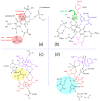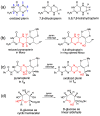Advancing Our Understanding of Pyranopterin-Dithiolene Contributions to Moco Enzyme Catalysis
- PMID: 38005178
- PMCID: PMC10673323
- DOI: 10.3390/molecules28227456
Advancing Our Understanding of Pyranopterin-Dithiolene Contributions to Moco Enzyme Catalysis
Abstract
The pyranopterin dithiolene ligand is remarkable in terms of its geometric and electronic structure and is uniquely found in mononuclear molybdenum and tungsten enzymes. The pyranopterin dithiolene is found coordinated to the metal ion, deeply buried within the protein, and non-covalently attached to the protein via an extensive hydrogen bonding network that is enzyme-specific. However, the function of pyranopterin dithiolene in enzymatic catalysis has been difficult to determine. This focused account aims to provide an overview of what has been learned from the study of pyranopterin dithiolene model complexes of molybdenum and how these results relate to the enzyme systems. This work begins with a summary of what is known about the pyranopterin dithiolene ligand in the enzymes. We then introduce the development of inorganic small molecule complexes that model aspects of a coordinated pyranopterin dithiolene and discuss the results of detailed physical studies of the models by electronic absorption, resonance Raman, X-ray absorption and NMR spectroscopies, cyclic voltammetry, X-ray crystallography, and chemical reactivity.
Keywords: Moco; dithiolene; molybdenum cofactor; molybdenum enzymes; molybdopterin; pyranopterin.
Conflict of interest statement
The authors declare no conflict of interest.
Figures
























Similar articles
-
Molybdenum Cofactor Model Reveals Remarkable Redox Activity at Both Molybdenum and the Pyranopterin Dithiolene Ligand.J Am Chem Soc. 2025 May 7;147(18):15088-15099. doi: 10.1021/jacs.4c17577. Epub 2025 Apr 27. J Am Chem Soc. 2025. PMID: 40289353 Free PMC article.
-
Structure and reversible pyran formation in molybdenum pyranopterin dithiolene models of the molybdenum cofactor.J Am Chem Soc. 2012 Dec 5;134(48):19584-7. doi: 10.1021/ja310018e. Epub 2012 Nov 20. J Am Chem Soc. 2012. PMID: 23157708 Free PMC article.
-
Implications of Pyran Cyclization and Pterin Conformation on Oxidized Forms of the Molybdenum Cofactor.J Am Chem Soc. 2018 Oct 10;140(40):12808-12818. doi: 10.1021/jacs.8b05777. Epub 2018 Oct 2. J Am Chem Soc. 2018. PMID: 30200760 Free PMC article.
-
Resonance Raman spectroscopy of pyranopterin molybdenum enzymes.J Inorg Biochem. 2022 Oct;235:111907. doi: 10.1016/j.jinorgbio.2022.111907. Epub 2022 Jun 23. J Inorg Biochem. 2022. PMID: 35932756 Free PMC article. Review.
-
Molybdenum and tungsten oxygen transferases--and functional diversity within a common active site motif.Metallomics. 2014 Jan;6(1):15-24. doi: 10.1039/c3mt00177f. Metallomics. 2014. PMID: 24068390 Review.
Cited by
-
Active Site Characterization of a Campylobacter jejuni Nitrate Reductase Variant Provides Insight into the Enzyme Mechanism.Inorg Chem. 2024 Jul 22;63(29):13191-13196. doi: 10.1021/acs.inorgchem.4c01991. Epub 2024 Jul 10. Inorg Chem. 2024. PMID: 38984973 Free PMC article.
-
The Effect of Selenium-Based Ligands on Tungsten Acetylene Complexes.Inorg Chem. 2024 Jul 1;63(26):12255-12267. doi: 10.1021/acs.inorgchem.4c01636. Epub 2024 Jun 20. Inorg Chem. 2024. PMID: 38898818 Free PMC article.
-
Bond Valence Sum Parameters for Analyzing Pyranopterin Tungsten Enzyme Structures.Molecules. 2025 Feb 14;30(4):871. doi: 10.3390/molecules30040871. Molecules. 2025. PMID: 40005181 Free PMC article.
-
Vinyl-pyrazole as a biomimetic acetaldehyde surrogate.Chem Commun (Camb). 2024 Jul 2;60(54):6873-6876. doi: 10.1039/d4cc01305k. Chem Commun (Camb). 2024. PMID: 38832417 Free PMC article.
-
Second-Coordination-Sphere Effects Reveal Electronic Structure Differences between the Mitochondrial Amidoxime Reducing Component and Sulfite Oxidase.Inorg Chem. 2024 Oct 14;63(41):19063-19073. doi: 10.1021/acs.inorgchem.4c02157. Epub 2024 Sep 30. Inorg Chem. 2024. PMID: 39350518
References
-
- Ingersol L.J., Kirk M.L. Structure, Function, and Mechanism of Pyranopterin Molybdenum and Tungsten Enzymes. In: Constable E.C., Parkin G., Que L. Jr., editors. Comprehensive Coordination Chemistry III. Elsevier; Oxford, UK: 2021. pp. 790–811.
-
- Hille R., Schulzke C., Kirk M.L. Molybdenum and Tungsten Enzymes. The Royal Society of Chemistry; Cambridge, UK: 2017.
Publication types
MeSH terms
Substances
Grants and funding
LinkOut - more resources
Full Text Sources

